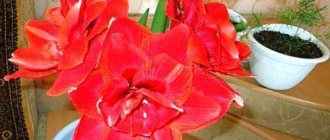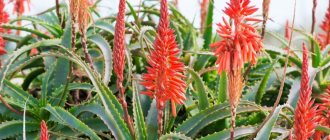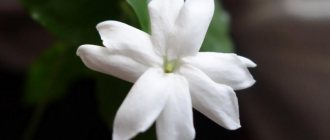Amaryllis was brought to Europe from South Africa.
It belongs to the amaryllis family and is represented by only two species. Hybrid forms and varieties of Amaryllis belladonna or beautiful amaryllis are grown in indoor culture. Dear readers!
For you, we have created communities on social networks in which useful articles and interesting ideas are published several times a day! Subscribe and receive useful content in a convenient format! The flower bulb can reach a diameter of 12 cm. Above the sword-shaped or linear pointed leaves rises a bare peduncle, crowned with funnel-shaped flowers, most often from 4 to 8.
In nature, lanceolate petals are white or pink. Cultivated varieties have a fairly rich color palette - from classic bright red to white, greenish, golden and purple.
How often does it bloom?
The plant has a pronounced period of complete dormancy, after which flowering is observed.
If we remember its origin, it becomes clear why it is observed in March - April.
At this time, the flower is in its homeland - late summer, autumn. When the end of spring comes and amaryllis rests for summer, winter has come for it.
Flowering time depends on the varietal of the flower and may occur at the end of winter or early spring. Some varieties bloom in summer or autumn.
If you organize forcing correctly, you can make amaryllis bloom at almost any desired time. But still, natural timing is preferable for this - the bulbs will be stronger, the plant itself will be healthier, and flowering will be annual and abundant. With proper care, re-blooming is possible in the same year.
Reproduction methods
Actually, there are three of them:
- children, or daughter bulbs;
- dividing the bulb;
- seeds.
The first method ( by children ) is the most common, convenient and easy. As a rule, by the end of the growing season, small children appear near the adult bulb. In the spring, when transplantation takes place, the children are separated from the mother bulb and planted in separate pots. Subsequently, they are cared for without providing a rest period, regularly increasing the pot. Two years pass in this way, and in the spring of the third, the mature bulb, as a rule, blooms.
Seed propagation is used less frequently, mainly because in this case you have to wait two years longer for flowering. Most often, the method is used to obtain new varieties and hybrids. But the method itself is simple, the seeds germinate smoothly and without problems.
It also happens that when caring for an amaryllis flower at home, you have to propagate it by dividing the bulb . This usually happens if the bulb is rare, there is only one, and for some reason it needs to be propagated without waiting for the children to appear. This method is risky and requires courage and acquired skills.
The essence of the method is that the onion is carefully cut into several parts. A prerequisite is to preserve a piece of the bottom and at least one scale on each part. The sections are treated with crushed coal and planted in almost dry but warm sand (at least +25ºС).
After about a month, under favorable conditions, the first leaf appears, followed by the second. At this stage, the sprouted parts of the bulb are planted in the soil, in their own separate pots.
Amaryllis flowering conditions
Sometimes, despite all efforts, amaryllis never blooms. To understand the reason for the failure, let’s consider all the necessary conditions for flowering. Experienced gardeners have long known that for a plant to successfully grow, conditions are necessary that are close to those found in its natural habitat.
Temperature
In the Cape Province, where amaryllis comes from, summers are hot and winters are quite cool. During the active growing season, the flower needs temperatures from 18 to 25 degrees. The difference between day and night temperatures should be minimal. When he is at rest, the temperature needs to be lowered.
Important! The minimum temperature for amaryllis at rest is +10 degrees.
Air humidity
When it is above 80%, the spread of the fungal disease stagonosporosis is possible. Therefore, the flower does not need additional air humidification. Only in extreme heat may it require spraying, but only in the morning or evening hours.
Lighting
Daylight hours during active growth are 16 hours. If necessary, use additional lighting. For a flower, bright but diffused light is preferable. It can be exposed to direct sunlight only in the morning - until 11 o'clock and in the afternoon - from 15 o'clock. At rest, amaryllis does not require light.
Location
It is chosen taking into account lighting needs. It is best if it is a window oriented to the southwest or southeast. On a south window, the flower will have to be shaded during the midday hours.
Important! To prevent the peduncle from bending, turn the pot three times a week.
Set of rules for flowering plants
If a flower is capable of blooming more than once a year, every gardener wants to boast about his skills in “communicating” with plants and show the result. Amaryllis is not picky. There are simply a few rules, if violated, you will have to grab your head and look for the answer to the question “what to do?”
All positions are associated with maximum approximation to natural growing conditions, which means that you will have to create good care for:
- bulbs (rotting roots should be removed so as not to cause rotting and other diseases in its soil);
- the safety of the flower (this even applies to the weight of the pot, so that the plant does not receive shock from falling due to overweight under the weight of its own leaves and arrows);
- dormant stage on time (from June to early September, the plant should be removed to a cool, dark place);
- alternating stages of rest and active watering, in parallel with feeding;
- flowering, making sure that there are no more than two arrows from one bulb, otherwise this will lead to depletion of the plant;
- the beginning of flowering (in the cramped space of the pot, the amaryllis releases arrows faster, and in a more free space, it gives strength to the birth of “babies”);
- proper watering (excessive moisture intake before the release of the peduncle can be detrimental to flowering, but in favor of foliage growth);
- equal development of the plant on all sides (access to lighting on each side of the amaryllis helps the plant develop equally and will not cause the plant to skew in any direction);
- bulbs (peduncles, so that the root system remains strong, should be cut off after flowering, and leaves that have lost their density should not be removed, because they return the remaining nutrients to the bulb).
Why doesn't amaryllis bloom?
There are usually two reasons for this:
- ignorance of the physiology of plant development;
- errors in care.
Let's look into this in more detail and work on the mistakes.
Not observing the rest period
Amaryllis differs from many room inhabitants in its period of complete rest.
All metabolic processes in the bulb slow down.
In preparation for rest, nutrients are transferred from dying leaves into it.
The flower needs to be prepared for this state:
- Reduce daylight hours, and then place the flower in a dark room.
- Gradually reduce the temperature.
- Reduce the number of waterings.
- Eliminate fertilizing.
After a full rest from autumn to spring, flowering will be abundant and long-lasting. Without it, the bulb quickly depletes and forms only leaves.
Wrong potty
Beginning flower growers may not realize that the wrong pot is an obstacle to flowering.
It would seem, what is the connection between the diameter of the pot and flowering? But it exists, and it is the most direct one. In a spacious pot, the plant readily produces children. We keep amaryllis in the house for spectacular flowering. And the plant blooms to produce seeds. A spacious pot stimulates vegetative propagation rather than flowering.
For this flower there is a rule: the diameter of the pot is 4 cm greater than the diameter of the bulb. Less is possible, more is not possible.
Advice! When choosing a container for amaryllis, purchase a stable pot, otherwise it may tip over under the weight of the peduncle.
Incorrect watering frequency
This is one of the common reasons for lack of flowering. At rest, the flower does not need full watering; it only needs a little moistening with a spray bottle. When moving to the windowsill it is continued.
The flower shoot has reached 10 cm - watering becomes regular. Moisten the soil after the top layer has dried slightly. The flower shoot has been cut off, but watering has not stopped.
The flower should grow leaves - they will nourish the bulb. When they begin to dry out, reduce watering. You need to water the flower along the walls of the pot; water should not get on the bulb.
Poorly selected soil
Lack of nutrients, too dense soil that does not allow moisture and air to pass through, will certainly affect flowering. The substrate for planting should include humus - 1 part, leaf soil - 3 parts.
For looseness, add perlite - 2 parts (can be replaced with coarse sand). Acidity is strictly monitored; its values should be within 6.0-6.5. If you do not have the skills to prepare nutrient mixtures, it is better to buy ready-made soil intended for amaryllis.
Important! The prepared soil needs to be sterilized.
Poorly chosen place for a flower
If there is not enough light, the plant may postpone flowering until better times. Direct sunlight is stressful for amaryllis. He will be uncomfortable in a draft and with frequent temperature fluctuations. All this must be taken into account when choosing a place for a flower.
Problems with the bulb
It must be remembered that even healthy planting material will produce flowers only in the third year. When the bulb is affected by disease, the plant will no longer be able to develop normally. Lack of flowering is observed if:
- there are too many children - we separate them from the mother’s bulb;
- improper care has led to a decrease in the size of the bulb - we ensure a full period of rest;
- it froze due to non-compliance with the temperature regime;
- improper storage during the dormant period;
- planting too deep.
When purchasing, you need to carefully check the planting material. For prevention, purchased bulbs are treated with a fungicide solution for half an hour.
Problems with fertilizer
Without proper nutrition there will be no flowers. The plant needs to regain its strength. To do this, it is fed every ten days while it is actively growing. Fertilizers for bulbs are suitable; dilute them in water according to the instructions.
Characteristics of amaryllis and species diversity
Amaryllis is a monotypic genus of perennial bulbous plants belonging to the Amaryllidaceae family. The only representative of the genus is Amaryllis belladonna, or Beautiful. The underground part of the plant is represented by a pear-shaped bulb consisting of a large number of scales. The diameter of the bulb can range from 6 to 12 cm. Fibrous roots are located on the bottom of the bulb.
The dense and narrow leaf plates of the flower are arranged in 2 rows, growing directly from the bulb. The length of the rich green leaves can reach half a meter, while their width rarely reaches even 2.5 cm. A smooth peduncle, represented by a bare stem, grows from the center of the bulb. As you can see in the photo, one peduncle can bear from 2 to 11 funnel-shaped buds, consisting of 6 elongated petals.
You may be interested in:
Growing ginger in a pot and caring for it at home Ginger is an Asian plant with worldwide popularity and a unique chemical composition. However, despite all...Read more...
The diameter of the flowers can reach 12 cm. In their natural habitat, you can find amaryllis with white or pink flowers, which exude a pleasant, unobtrusive aroma. However, thanks to the hard work of breeders, several varieties with a wide variety of colors were developed based on Amaryllis the Beautiful.
The most popular varieties of amaryllis include:
- Durban. This variety is distinguished by large red inflorescences with whitish streaks at the base.
Durban - Parker. Amaryllis Parker petals are bright pink, but have a yellow throat at the base.
Parker - Terry nymph. The variety stands out for its double flowers, painted in a soft pink color.
Terry nymph - The Snow Queen. A large-flowered variety, the white flowers of which are covered with a light glossy coating.
The Snow Queen - Red lion. It is one of the most popular amaryllis varieties. During flowering, medium-sized, rich red buds appear on the leathery peduncles.
red lion
There are many varieties of amaryllis, which differ from each other not only in the color of the flowers, but also in their shape. Breeders are trying to develop as many interesting varieties with large, variegated flowers as possible.
Care during flowering
Amaryllis flowering lasts up to 20 days. All this time, regular watering is carried out, not forgetting to pour out excess water from the pan. Spraying is not carried out at this time - spots may appear on the petals. Experienced flower growers advise cutting off the first arrow after one flower blooms. It will stand in the water for a long time, but a second one will appear to replace it.
Advice! Usually there are up to 3 flower arrows on amaryllis, but it is better to break off the third one immediately so as not to weaken the plant.
The pot is turned several times a week - then the peduncle will not bend.
How to care at different times for flowering?
This plant can be forced to bloom at any time by creating an artificial dormant period. If it falls in November-December, the monthly care for the plant will be as follows.
January
If the plant is dormant, no care is required. Only every week you need to spray the soil with a spray bottle. At the end of January it’s time to put pots of bulbs on the windowsill. If they have been stored in the refrigerator, it's time to plant them in pots.
February
The sun woke up the bulbs. They are slowly waking up, a flower arrow has appeared. At this time, it is enough to occasionally spray the soil in the pot. If the length of the arrow goes beyond 10 cm, water and feed according to the usual scheme.
March
The most important period in care is the time of flowering. Watering and fertilizing should be regular.
April
Flowering ends. It's time to trim the flower shoot. It is good to feed the plant to restore strength.
May
If necessary, you can replant the flower or plant it in the ground when the threat of frost has passed and the temperature is not lower than 18 degrees. Water and feed.
June
Continue watering and fertilizing.
July
The care is the same. Do not forget to protect plants from the scorching heat.
August
Continue to water and feed. At the end of the month, it’s time to move the flower into the apartment, if it grew on the street - cold weather may come suddenly.
September
It's time to prepare for winter rest. Gradually reduce watering and remove fertilizing.
October
By the end of the month they stop watering. Remove completely dried leaves.
November
At the beginning of the month, the flower is transferred to a cool and dark room. Spray the soil in the pot weekly.
December
A state of deep peace. No maintenance required other than spraying
Typically, such care is needed for a flower if a dormant period is created artificially. In nature, it falls in July and August, and the care schedule shifts accordingly.
Answers on questions
Many gardeners often have questions about flower care. Let's try to answer the most frequently asked questions.
Why doesn't it bloom, but only produces leaves?
There may be several reasons:
- a baby was planted that blooms only after 3 years;
- too spacious pot or deep planting;
- the rest period is not observed;
- watering the flower before the arrow has grown to 10 cm;
- improper watering, light or temperature conditions;
- lack of nutrition.
What to do with the bulb after flowering?
If there is a need, it can be transplanted. Continue care until the leaves wither.
What to do with the arrow after flowering?
When it begins to wither, it is cut off.
Is it possible to replant a flowering one after purchase?
It is better to wait until flowering ends. The soil of the purchased flower does not absorb moisture well, so you need to pay special attention to watering.
Growing and transplanting amaryllis at home
Amaryllis reproduces in several ways: by seeds and bulbous children:
- Growing amaryllis from seeds is a rather long and labor-intensive process, and the plant obtained from seeds will bloom only after 5 years. To obtain seeds, the plant must be pollinated manually using a regular brush. The seeds are localized in the box and collected only after it dries. Fresh seeds are sown in a nutritious and loose substrate, and the container with seedlings is placed in a warm and well-lit place.
Amaryllis seeds - Reproduction with the help of children is a quick and reliable way to get a new flower. Children appear exclusively from a healthy and mature mother plant. Immediately after separation, the babies are seated in small containers filled with a sand-perlite mixture for growing up. The strengthened bulbs are transplanted into permanent soil. With proper care, after 2-3 years, a plant grown from children will be capable of flowering.
The plant does not require private replanting. It is enough to replant the flower into a new container once every 2-4 years. But it is better to carry out partial soil replacement annually. It is recommended to carry out the transplantation procedure 3-4 weeks after the end of flowering.
The transplant is performed in the following sequence:
- A 2-3 cm drainage layer is laid out at the bottom of the pre-prepared pot. Expanded clay, crushed stone, small pebbles or broken shards can be used as drainage.
- A soil mixture consisting of turf, leaf soil, peat, humus and sand, taken in equal quantities, is poured over the drainage.
Soil for planting - The flower is carefully removed from the old container and inspected for damage and disease. If necessary, damaged areas of the bulb are removed, and the cut sites are treated with antifungal drugs.
- The planting material is immersed in a weak solution of potassium permanganate for a quarter of an hour and dried.
- The bulb is 2/3 immersed in the ground with its blunt end down.
Planting a bulb - The soil around the flower is carefully compacted.
- The plant is watered with soft water at room temperature.
It is recommended to use a deep pot as a new container, the diameter of which will be 3-4 cm larger than the bulb.
You may be interested in:
Hippeastrum - caring for a houseplant at home Hippeastrums are distinguished by their sophistication and exoticism. The decorative value of the plant is its...Read more...
Common mistakes
The most common mistake is not observing the rest period or switching to it too abruptly. The plant must be prepared gradually. Sometimes the wrong place is chosen for a plant, the temperature regime is not observed, and it is planted in the wrong soil.
If you water too much, the roots may rot. Lack of moisture will not allow amaryllis to bloom and develop well. Some gardeners start watering when the arrow just hatches, and as a result they do not get flowering, the plant grows leaves.











